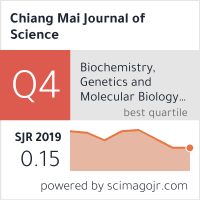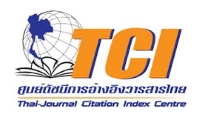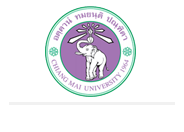JOURNAL DETAIL
Water Footprint and Virtual Water Flow of Cassava Starch of Thailand
Paper Type |
Contributed Paper |
Title |
Water Footprint and Virtual Water Flow of Cassava Starch of Thailand |
Author |
Manuswee Phanichnok, Khanidtha Meevasana and Pongthep Suwanwaree* |
Email |
pongthep@sut.ac.th |
|
Abstract: Cassava starch is a crucial agro-industry in Thailand. Cassava is extensively cultivated and
processed into the final products in the country to be consumed and exported. Cassava cultivation and
processing have a large impact on water resources, and also creates stress on water availability. Water
footprint (WF) is the tool used for measuring the total amount of water consumed by an individual or
an entire nation, and can be used to provide a clear overview mapping of water use during the time in
which the product is consumed or traded. The aims of this study were to calculate the average WF of
cassava starch production from crop to final product consumed under the WF concept methodology,
and to assess the virtual water flow (VWF) of cassava starch trade in Thailand during the period of
2008-2013. The results showed that the average WF of crop cultivation was equal to 528 m3/ton,
consisting of green (187 m3/ton), blue (251 m3/ton) and grey (90 m3/ton) components. The average
WF of cassava starch was equal to 1,945 m3/ton product, consisting of green (678 m3/ton), blue
(925 m3/ton) and grey (342 m3/ton), respectively. The amount of water required for crop cultivation
is associated with the climatic and soil conditions. Moreover, adopting good farming practices and
the most efficient irrigated water scheduling can reduce the amount of water needed per ton of crop
cultivation. However, the water used in crop processing depends on processing operation and technology.
The VWF of global exported cassava starch from Thailand was 3.68 billion m3/year, almost 85% of
which was distributed throughout Asia. The largest importers of cassava starch are China, Indonesia
and Taiwan. The import of cassava starch might be able to support countries that have water scarcity
problems. Instead of cultivating and processing it nationally, the import of cassava starch can help
lessen the burden on domestic water resources.
|
|
Start & End Page |
1129 - 1142 |
Received Date |
2018-01-25 |
Revised Date |
|
Accepted Date |
2019-08-20 |
Full Text |
Download |
File Supplemental |
Download Supplemental |
Keyword |
cassava, water footprint, crop cultivation , processing, trade, Thailand |
Volume |
Vol.46 No.6 (November 2019) |
DOI |
|
Citation |
Phanichnok M., Meevasana K. and Suwanwaree* P., Water Footprint and Virtual Water Flow of Cassava Starch of Thailand, Chiang Mai Journal of Science, 2019; 46(6): 1129-1142. |
| View:1,195 Download:1,202 | |
RELATED ARTICLE
Future Projections of Precipitation and Temperature in Northeast, Thailand using Bias-Corrected Global Climate Models
Article ID: e2023041
Author:Wittanan Tammadid, Ketmanee Nantasom, Wichayaporn Sirksiri, Supika Vanitchung, Chaiwatchara Promjittiphong, Atsamon Limsakul and Phongthep Hanpattanakit
Vol.50 No.4 (July 2023) View: 1,404 Download:1,289
Article ID: e2023041
Author:Wittanan Tammadid, Ketmanee Nantasom, Wichayaporn Sirksiri, Supika Vanitchung, Chaiwatchara Promjittiphong, Atsamon Limsakul and Phongthep Hanpattanakit
Vol.50 No.4 (July 2023) View: 1,404 Download:1,289
https://gmsmushrooms.org/: A comprehensive Online Database of Mushrooms in the Greater Mekong Sub Region
page: 538 - 550
Author:Monthien Phonemany, Allen Grace T. Niego, Samantha C. Karunarathna, Yuwei Hu, Thatsanee Luangharn, Phongeun Sysouphanthong, Saisamorn Lumyong, Rui-Lin Zhao, Mao-Qiang He, Naritsada Thongklang and Kevin D. Hyde
Vol.49 No.3 (Special Issue II : May 2022) View: 1,918 Download:804
page: 538 - 550
Author:Monthien Phonemany, Allen Grace T. Niego, Samantha C. Karunarathna, Yuwei Hu, Thatsanee Luangharn, Phongeun Sysouphanthong, Saisamorn Lumyong, Rui-Lin Zhao, Mao-Qiang He, Naritsada Thongklang and Kevin D. Hyde
Vol.49 No.3 (Special Issue II : May 2022) View: 1,918 Download:804
Effect of Alkaline Pretreatment on the Properties of Cassava Rhizome
page: 1511 - 1523
Author:Kamonwat Nakason, Pongtanawat Khemthong, Wasawat Kraithong, Suwisa Mahasandana and Bunyarit Panyapinyopol
Vol.48 No.6 (November 2021) View: 1,633 Download:710
page: 1511 - 1523
Author:Kamonwat Nakason, Pongtanawat Khemthong, Wasawat Kraithong, Suwisa Mahasandana and Bunyarit Panyapinyopol
Vol.48 No.6 (November 2021) View: 1,633 Download:710
The Effects of the Extracts of Euphorbiae Semen Before and After Being Processed into Frost Powder on Rats’ Intestinal Flora with q-PCR
page: 90 - 99
Author:Hui Gao, Yingzi Wang*, Yao Zhang, Jingzhen Zhang, Yuexin Cui, Xinjie Wang, Siyu Wang, Taiji Yang and Yang Yang
Vol.48 No.1 (January 2021) View: 1,130 Download:371
page: 90 - 99
Author:Hui Gao, Yingzi Wang*, Yao Zhang, Jingzhen Zhang, Yuexin Cui, Xinjie Wang, Siyu Wang, Taiji Yang and Yang Yang
Vol.48 No.1 (January 2021) View: 1,130 Download:371
The sidA Gene of Aureobasidium thailandense and its Phylogenetic Relationship among those of Aureobasidium Species
page: 13 - 26
Author:Vorawat Kitiyanant, Chompoonik Kanchanabanca, Hunsa Punnapayak, Anchittha Satjarak, Pongtharin Lotrakul* and Sehanat Prasongsuk*
Vol.48 No.1 (January 2021) View: 1,031 Download:671
page: 13 - 26
Author:Vorawat Kitiyanant, Chompoonik Kanchanabanca, Hunsa Punnapayak, Anchittha Satjarak, Pongtharin Lotrakul* and Sehanat Prasongsuk*
Vol.48 No.1 (January 2021) View: 1,031 Download:671
Genetic Relationships Between Globba expansa (Zingiberaceae) and Other Closely Related Taxa in
Thailand Using HAT-RAPD Marker Analysis
page: 896 - 906
Author:Sunisa Sangvirotjanapat, Pramote Triboun, Mark Newman and Jessada Denduangboriphant*
Vol.46 No.5 (September 2019) View: 974 Download:800
page: 896 - 906
Author:Sunisa Sangvirotjanapat, Pramote Triboun, Mark Newman and Jessada Denduangboriphant*
Vol.46 No.5 (September 2019) View: 974 Download:800
Assessment and Ranking of Hot Springs Sites Representing Geothermal Resources in Southern
Thailand using Positive Attitude Factors
page: 592 - 608
Author:Wipada Ngansom and Helmut Duerrast *
Vol.46 No.3 (May 2019) View: 1,514 Download:375
page: 592 - 608
Author:Wipada Ngansom and Helmut Duerrast *
Vol.46 No.3 (May 2019) View: 1,514 Download:375
Development of Recommendations for Site Investigations of waste Disposal Sites in Thailand
page: 235 - 245
Author:Jens Radschinski* and Hans-Jürgen Voigt
Vol.30 No.3 (DECEMBER 2003) View: 837 Download:304
page: 235 - 245
Author:Jens Radschinski* and Hans-Jürgen Voigt
Vol.30 No.3 (DECEMBER 2003) View: 837 Download:304
Investigation of Plasmodium vivax Rhomboid-like Protease 1 Compared to Plasmodium falciparum Rhomboid Protease 1 in Erythrocytic Cycle
page: 2256 - 2266
Author:Touchchapol Mataradchakul, Chairat Uthaipibull, Joel Vega-Rodriguez, Marcelo Jacobs-Lorena and Usa Lek-Uthai
Vol.45 No.6 (September 2018) View: 980 Download:283
page: 2256 - 2266
Author:Touchchapol Mataradchakul, Chairat Uthaipibull, Joel Vega-Rodriguez, Marcelo Jacobs-Lorena and Usa Lek-Uthai
Vol.45 No.6 (September 2018) View: 980 Download:283
Gas Chromatographic-Flame Photometric Detection of Organophosphate Pesticide Residues and Its Application in Real Vegetable and Fruit Samples from Chiang Mai City, Thailand
page: 1933 - 1943
Author:Watcharapol Polyiem, Warangkana Naksen and Tippawan Prapamontol
Vol.45 No.4 (July 2018) View: 1,272 Download:322
page: 1933 - 1943
Author:Watcharapol Polyiem, Warangkana Naksen and Tippawan Prapamontol
Vol.45 No.4 (July 2018) View: 1,272 Download:322
Open Source Library-based 3D Face Point Cloud Generation
page: 1875 - 1887
Author:Bulent Bayram, Taskin Ozkan, Hatice Catal Reis, Tolga Bakirman, Ibrahim Cetin and Dursun Zafer Seker
Vol.45 No.4 (July 2018) View: 1,377 Download:409
page: 1875 - 1887
Author:Bulent Bayram, Taskin Ozkan, Hatice Catal Reis, Tolga Bakirman, Ibrahim Cetin and Dursun Zafer Seker
Vol.45 No.4 (July 2018) View: 1,377 Download:409
A Complete System for Renewable Utilization of Cassava to Biohydrogen Coupled with Biomethane as Zero-Waste Management
page: 1214 - 1224
Author:Wilawan Channarong, Mongkol Ngamjarearnwong, Churapa Teerapatsakul and Lerluck Chitradon*
Vol.45 No.3 (May 2018) View: 1,001 Download:288
page: 1214 - 1224
Author:Wilawan Channarong, Mongkol Ngamjarearnwong, Churapa Teerapatsakul and Lerluck Chitradon*
Vol.45 No.3 (May 2018) View: 1,001 Download:288
Applications of Oxidized Chitosan for Scale Prevention in Sugar Evaporators
page: 961 - 972
Author:Tu Phuong Pham Le and Wanwipa Siriwatwechakul*
Vol.45 No.2 (March 2018) View: 935 Download:362
page: 961 - 972
Author:Tu Phuong Pham Le and Wanwipa Siriwatwechakul*
Vol.45 No.2 (March 2018) View: 935 Download:362
First Record of Platybaetis bishopi Mller-Liebenau, 1980 and Baetiella bispinosa (Gose, 1980) (Ephemeroptera: Baetidae) from Thailand
page: 774 - 783
Author:Sirikamon Phlai-ngam and Nisarat Tungpairojwong*
Vol.45 No.2 (March 2018) View: 929 Download:596
page: 774 - 783
Author:Sirikamon Phlai-ngam and Nisarat Tungpairojwong*
Vol.45 No.2 (March 2018) View: 929 Download:596
Crustal Structures, Geothermal Sources and Pathways Beneath Northern Thailand Revealed
by Local Earthquake Tomography
page: 565 - 575
Author:Kasemsak Saetang, Wilaiwan Srisawat and Helmut Dürrast
Vol.45 No.1 (January 2018) View: 998 Download:616
page: 565 - 575
Author:Kasemsak Saetang, Wilaiwan Srisawat and Helmut Dürrast
Vol.45 No.1 (January 2018) View: 998 Download:616
Simultaneous Saccharification and Fermentation of L-(+)-Lactic Acid Production from Liquefied Cassava Starch by Immobilized Rhizopus oryzae in a 3 L Airlift Fermenter
page: 77 - 91
Author:Srisakul Trakarnpaiboon, Suthasinee Praneetrattananon and Vichien Kitpreechavanich
Vol.45 No.1 (January 2018) View: 1,297 Download:538
page: 77 - 91
Author:Srisakul Trakarnpaiboon, Suthasinee Praneetrattananon and Vichien Kitpreechavanich
Vol.45 No.1 (January 2018) View: 1,297 Download:538
Name-alias Relationship Identification in Thai News Articles: A Comparison of
Co-occurrence Matrix Construction Methods
page: 1805 - 1821
Author:Thawatchai Suwanapong*, Thanaruk Theeramunkong and Ekawit Nantajeewarawat
Vol.44 No.4 (October 2017) View: 1,887 Download:375
page: 1805 - 1821
Author:Thawatchai Suwanapong*, Thanaruk Theeramunkong and Ekawit Nantajeewarawat
Vol.44 No.4 (October 2017) View: 1,887 Download:375
Two New Records of Lichens of Thelotremoid Graphidaceae (Ascomycota: Ostropales) from Thailand
page: 1392 - 1394
Author:Khwanyuruan Naksuwankul* and H. Thorsten Lumbsch
Vol.44 No.4 (October 2017) View: 959 Download:248
page: 1392 - 1394
Author:Khwanyuruan Naksuwankul* and H. Thorsten Lumbsch
Vol.44 No.4 (October 2017) View: 959 Download:248
Genetic Divergence of Austroasiatic Speaking Groups in the Northeast of Thailand: A Case Study
on Northern Khmer and Kuy
page: 1279 - 1294
Author:Panthipa Chantakot, Pittayawat Pittayaporny, Kanokpohn Srithongdaeng, Suparat Srithawong and Wibhu
Vol.44 No.4 (October 2017) View: 1,005 Download:769
page: 1279 - 1294
Author:Panthipa Chantakot, Pittayawat Pittayaporny, Kanokpohn Srithongdaeng, Suparat Srithawong and Wibhu
Vol.44 No.4 (October 2017) View: 1,005 Download:769
Tectonic Evolution of the Thonburi Basin in the Lower Central Plain, Thailand
page: 1306 - 1315
Author:Kamontip Nuangchamnong [a], Phumee Srisuwon [b] and Passakorn Pananont* [a]
Vol.43 No.6 (SPECIAL ISSUE 2) View: 923 Download:442
page: 1306 - 1315
Author:Kamontip Nuangchamnong [a], Phumee Srisuwon [b] and Passakorn Pananont* [a]
Vol.43 No.6 (SPECIAL ISSUE 2) View: 923 Download:442
Shear wave velocity estimation of the near-surface sediments of Bangkok and vicinity, Thailand for seismic site characterization
page: 1269 - 1278
Author:Aomboon Naksawee [a], Koich Hayashi [b] and Passakorn Pananont* [a]
Vol.43 No.6 (SPECIAL ISSUE 2) View: 2,720 Download:456
page: 1269 - 1278
Author:Aomboon Naksawee [a], Koich Hayashi [b] and Passakorn Pananont* [a]
Vol.43 No.6 (SPECIAL ISSUE 2) View: 2,720 Download:456
Comparative Effects of High Hydrostatic Pressure and Thermal Processing on Physicochemical Properties and Bioactive Components of Mao Luang (Antidesma bunius Linn.) Juice
page: 851 - 862
Author:Pittaya Chaikham*[a] and Sasitorn Baipong [b]
Vol.43 No.4 (JULY 2016) View: 1,261 Download:228
page: 851 - 862
Author:Pittaya Chaikham*[a] and Sasitorn Baipong [b]
Vol.43 No.4 (JULY 2016) View: 1,261 Download:228
Observations of Cloud Condensation Nuclei (CCN) in Northern Thailand
page: 767 - 776
Author:Thitikorn Chanyatham*, Pakdee Chantraket and Nuenghatai Tantiplubthong
Vol.43 No.4 (JULY 2016) View: 1,385 Download:358
page: 767 - 776
Author:Thitikorn Chanyatham*, Pakdee Chantraket and Nuenghatai Tantiplubthong
Vol.43 No.4 (JULY 2016) View: 1,385 Download:358
Isolation and Screening of Lactobacillus plantarum Strains from Attieke Fermentation Process for
A Starter Culture Development
page: 699 - 711
Author:Krabi Ekoua Regina[a], Assamoi Allah Antoine*[a], Ehon Ayawovi Fafadzi[a], Brehima Diawara [b], Niamke Lamine Sebastien [a] and Thonart Philippe [c]
Vol.43 No.4 (JULY 2016) View: 996 Download:450
page: 699 - 711
Author:Krabi Ekoua Regina[a], Assamoi Allah Antoine*[a], Ehon Ayawovi Fafadzi[a], Brehima Diawara [b], Niamke Lamine Sebastien [a] and Thonart Philippe [c]
Vol.43 No.4 (JULY 2016) View: 996 Download:450
Tracking of moving object using energy of biorthogonal wavelet transform
page: 783 - 795
Author:Om Prakash, Ashish Khare
Vol.42 No.3 (JULY 2015) View: 849 Download:238
page: 783 - 795
Author:Om Prakash, Ashish Khare
Vol.42 No.3 (JULY 2015) View: 849 Download:238
The Genus Butea Roxb. ex Willd. (Leguminosae-Papilionoideae) in Thailand
page: 367 - 375
Author:Sakuntala Ninkaew and Pranom Chantaranothai
Vol.42 No.2 (APRIL 2015) View: 974 Download:392
page: 367 - 375
Author:Sakuntala Ninkaew and Pranom Chantaranothai
Vol.42 No.2 (APRIL 2015) View: 974 Download:392
Betel-like-scented Piper Plants as Diverse Sources of Industrial and Medicinal Aromatic Chemicals
page: 1171 - 1181
Author:Arisa Sanubol [a], Arunrat Chaveerach*[a], Runglawan Sudmoon [a], Tawatchai Tanee [b], Kowit Noikotr
Vol.41 No.5/1 (OCTOBER 2014) View: 1,591 Download:308
page: 1171 - 1181
Author:Arisa Sanubol [a], Arunrat Chaveerach*[a], Runglawan Sudmoon [a], Tawatchai Tanee [b], Kowit Noikotr
Vol.41 No.5/1 (OCTOBER 2014) View: 1,591 Download:308
Effects of Reprocessing on the Structure and Properties of Polycarbonate/Multi-Walled Carbon Nanotube Based Electrostatic Dissipative Composites
page: 261 - 273
Author:Darunee Aussawasathien*, Natcha Prakymoramas, and Dumrong Thanomjitr
Vol.40 No.2 (APRIL 2013) View: 884 Download:276
page: 261 - 273
Author:Darunee Aussawasathien*, Natcha Prakymoramas, and Dumrong Thanomjitr
Vol.40 No.2 (APRIL 2013) View: 884 Download:276
A New Species of Bactrachospermum, B. khaoluangensis Chankaew, Peerapornpisal et Kumano, sp. Nov. (Batrachospermales, Rhodophyta) from Thailand
page: 1 - 10
Author:Wanninee Chankaew*[a,b], Yuwadee Peerapornpisal[c], Shigeru Kumano[d] and Chatchai Ngamriabsakul[a]
Vol.40 No.1 (JANUARY 2013) View: 923 Download:299
page: 1 - 10
Author:Wanninee Chankaew*[a,b], Yuwadee Peerapornpisal[c], Shigeru Kumano[d] and Chatchai Ngamriabsakul[a]
Vol.40 No.1 (JANUARY 2013) View: 923 Download:299
Microstructures in Pyrope Garnets from Thailand
page: 669 - 677
Author:Bongkot Phichaikamjornwut, Henrik Skogby, Prayote Ounchanum, Phisit Limtrakun and Apichet Boonsoong
Vol.39 No.4 (OCTOBER 2012) View: 815 Download:309
page: 669 - 677
Author:Bongkot Phichaikamjornwut, Henrik Skogby, Prayote Ounchanum, Phisit Limtrakun and Apichet Boonsoong
Vol.39 No.4 (OCTOBER 2012) View: 815 Download:309
Evaluation of Precipitation Simulations over Thailand using a
WRF Regional Climate Model
page: 623 - 638
Author:Chakrit Chotamonsak *[a], Eric P. Salathé Jr. [b], Jiemjai Kreasuwan [c] and Somporn Chantara [a]
Vol.39 No.4 (OCTOBER 2012) View: 867 Download:284
page: 623 - 638
Author:Chakrit Chotamonsak *[a], Eric P. Salathé Jr. [b], Jiemjai Kreasuwan [c] and Somporn Chantara [a]
Vol.39 No.4 (OCTOBER 2012) View: 867 Download:284
Diversity of Edible Cladophora (Cladophorales, Chlorophyta) in Northern and Northeastern Thailand, Based on Morphology and Nuclear Ribosomal DNA Sequences
page: 300 - 310
Author:Sorrachat Thiamdao* [a], Ga Hun Boo [b], Sung Min Boo [b] and Yuwadee Peerapornpisal [a, c]
Vol.39 No.2 (APRIL 2012) View: 2,523 Download:238
page: 300 - 310
Author:Sorrachat Thiamdao* [a], Ga Hun Boo [b], Sung Min Boo [b] and Yuwadee Peerapornpisal [a, c]
Vol.39 No.2 (APRIL 2012) View: 2,523 Download:238
Nostochopsis lobatus Wood em. Geitler (Nostocales), Edible Algae in Northern Thailand
page: 119 - 127
Author:Sorrachat Thiamdao, Manita Motham, Jeeraporn Pekkoh, Lapatrada Mungmai and Yuwadee Peerapornpisal
Vol.39 No.1 (JANUARY 2012) View: 976 Download:257
page: 119 - 127
Author:Sorrachat Thiamdao, Manita Motham, Jeeraporn Pekkoh, Lapatrada Mungmai and Yuwadee Peerapornpisal
Vol.39 No.1 (JANUARY 2012) View: 976 Download:257
Water Quality and Trophic Status in Main Rivers of
Thailand
page: 280 - 294
Author:Pongpan Leelahakriengkrai*[a] and Yuwadee Peerapornpisal [a,b]
Vol.38 No.2 (APRIL 2011) View: 879 Download:456
page: 280 - 294
Author:Pongpan Leelahakriengkrai*[a] and Yuwadee Peerapornpisal [a,b]
Vol.38 No.2 (APRIL 2011) View: 879 Download:456
Genetical Diversity of Mastigocladus in Ranong
Hot Spring, Southern Part of Thailand
page: 363 - 370
Author:Udomluk Sompong* [a], Richard W. Castenholz [b], Somboon Anuntalabhochai [a] and Yuwadee Peerapornp
Vol.33 No.3 (SEPTEMBER 2006) View: 1,449 Download:410
page: 363 - 370
Author:Udomluk Sompong* [a], Richard W. Castenholz [b], Somboon Anuntalabhochai [a] and Yuwadee Peerapornp
Vol.33 No.3 (SEPTEMBER 2006) View: 1,449 Download:410
Microcystin LR Content in Microcystis aeruginosa
Kütz Collected from Sri Sakhett, Thailand
page: 231 - 236
Author:Waya Sengpracha [a], Napattarapong Suvannachai [b] and Weerachai Phutdhawong* [b]
Vol.33 No.2 (MAY 2006) View: 1,012 Download:320
page: 231 - 236
Author:Waya Sengpracha [a], Napattarapong Suvannachai [b] and Weerachai Phutdhawong* [b]
Vol.33 No.2 (MAY 2006) View: 1,012 Download:320
Fabrication and Characterization of High Strength
Dental Porcelain Nanocomposite from Thailandís
Raw Materials
page: 549 - 553
Author:Attavit Pisitanusorn*[a], Supon Ananta [a], Rattikorn Yimnirun [a] and Sakdipown Thiansem [b]
Vol.32 No.3 (SEPTEMBER 2005) View: 880 Download:247
page: 549 - 553
Author:Attavit Pisitanusorn*[a], Supon Ananta [a], Rattikorn Yimnirun [a] and Sakdipown Thiansem [b]
Vol.32 No.3 (SEPTEMBER 2005) View: 880 Download:247
Artificial Neural Network Time Series Modeling forRevenue Forecasting
page: 411 - 426
Author:Siti M. Shamsuddin, Roselina Sallehuddin and Norfadzila M. Yusof
Vol.35 No.3 (SEPTEMBER 2008) View: 956 Download:281
page: 411 - 426
Author:Siti M. Shamsuddin, Roselina Sallehuddin and Norfadzila M. Yusof
Vol.35 No.3 (SEPTEMBER 2008) View: 956 Download:281
Data Preprocessing in Multilayer Perceptron Modelling
page: 43 - 48
Author:Ku R. Ku-Mahamud*, Aniza M. Din and Fathilah M. Alipiah
Vol.29 No.1 (APRIL 2002) View: 838 Download:242
page: 43 - 48
Author:Ku R. Ku-Mahamud*, Aniza M. Din and Fathilah M. Alipiah
Vol.29 No.1 (APRIL 2002) View: 838 Download:242
Ruminal and Intestinal Digestibilities of Protein Foliages in Crossbred Cattle
page: 45 - 49
Author:Pramote Paengkoum [a], Juan B. Liang [a], Mohamad Basery [b] and Zainal A. Jelan [a]
Vol.28 No.1 (JUNE 2001) View: 846 Download:228
page: 45 - 49
Author:Pramote Paengkoum [a], Juan B. Liang [a], Mohamad Basery [b] and Zainal A. Jelan [a]
Vol.28 No.1 (JUNE 2001) View: 846 Download:228
Fifty Three New Record Species of Benthic Diatoms from Mekong River and Its Tributaries in Thailand
page: 326 - 343
Author:Sutthawan Suphan, and Yuwadee Peerapornpisal
Vol.37 No.2 (MAY 2010) View: 867 Download:259
page: 326 - 343
Author:Sutthawan Suphan, and Yuwadee Peerapornpisal
Vol.37 No.2 (MAY 2010) View: 867 Download:259
Determination of Local Tobacco Cultivars Using ISSR Molecular Marker
page: 293 - 303
Author:Jessada Denduangboripant, Sornsuda Setaphan, Wilasinee Suwanprasart, and Somsak Panha
Vol.37 No.2 (MAY 2010) View: 912 Download:352
page: 293 - 303
Author:Jessada Denduangboripant, Sornsuda Setaphan, Wilasinee Suwanprasart, and Somsak Panha
Vol.37 No.2 (MAY 2010) View: 912 Download:352
Copyrights © Since 2021 All Rights Reserved by Chiang Mai Journal of Science










